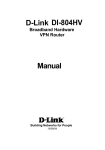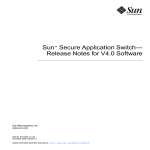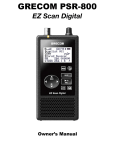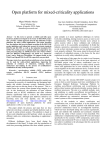Download D-Link DI-804HV - Express ENwork Router Specifications
Transcript
D-Link DI-804HV Broadband Hardware T M VPN Router Manual Building Networks for People 02212003 Contents Package Contents ................................................................................ 3 Introduction........................................................................................... 4 Getting Started ................................................................................... 10 Using the Configuration Menu ............................................................. 11 Networking Basics ............................................................................. 57 Reset to Factory Default Settings ........................................................ 83 Technical Specifications ..................................................................... 84 Contacting Technical Support ............................................................. 85 Warranty and Registration ................................................................... 86 2 Package Contents Contents of Package: n n n n n D-Link DI-804HV Broadband Hardware VPN Router Power Adapter – 5V DC Ethernet (CAT5-UTP/Straight-Through) Cable Manual on CD Quick Installation Guide Note: Using a power supply with a different voltage rating than the one included with the DI-804HV will cause damage and void the warranty for this product. If any of the above items are missing, please contact your reseller. System Requirements For Configuration: n Ethernet-Based Cable or DSL Modem n Computer with Windows, Macintosh, or Linux-based operating system with an installed Ethernet adapter n Internet Explorer version 6.x or Netscape Navigator version 6.x and above, with JavaScript enabled 3 Introduction The D-Link DI-804HV is a 4-port Broadband Router with Virtual Private Network (VPN) functionality. It provides a complete solution for Internet surfing and office resources sharing. It is an ideal way to extend the reach and number of computers connected to your network. After completing the steps outlined in the Quick Installation Guide (included in your package) you will have the ability to share information and resources. The DI-804HV is compatible with most popular operating systems, including Macintosh, Linux and Windows, and can be integrated into a large network. 4 Connections All Ethernet ports auto-sense c able ty pes t o ac c omodate str aight- through or c ross-over cable. WAN port is the connection for the Ethernet cable to the Cable or DSL modem Receptor for the Power Adapt er COM port provides serial connection for dial-up analog modem. LAN ports provide connections to Ethernetenabled devices. Pressing the Reset Button restores the router to its original factory default settings. Features & Benefits n Broadband modem and IP sharing Connects multiple computers to a broadband (cable or DSL) modem to surf the Internet n Auto-sensing Ethernet Switch Equipped with a 4-port auto-sensing Ethernet switch n VPN Pass-Through supported Supports pass-through VPN sessions and allows you to setup VPN server and VPN clients n Firewall All unwanted packets from outside intruders are blocked to protect your network n DHCP server supported All of the networked computers can retrieve TCP/IP settings automatically from the DI-804HV n Web-based configuration Configurable through any networked computer’s web browser using Netscape or Internet Explorer 5 Features & Benefits continued n Access Control supported Allows you to assign different access rights for different users n Packet filter supported Packet Filter allows you to control access to a network by analyzing the incoming and outgoing packets and letting them pass or halting them based on the IP address of the source and destination. n Virtual Server supported Enables you to expose WWW, FTP and other services on your LAN to be accessible to Internet users. n User-Definable Application Sensing Tunnel User can define the attributes to support special applications requiring multiple connections, like Internet gaming, video conferencing, Internet telephony and so on. The DI-804HV can sense the application type and open a multi-port tunnel for it. n DMZ Host supported Allows a networked computer to be fully exposed to the Internet; this function is used when the special “application-sensing tunnel feature” is insufficient to allow an application to function correctly Introduction to Broadband Router Technology A router is a device that forwards data packets from a source to a destination. Routers forward data packets using IP addresses and not a MAC address. A router will forward data from the Internet to a particular computer on your LAN. The information that makes up the Internet gets moved around using routers. When you click on a link on a web page, you send a request to a server to show you the next page. The information that is sent and received from your computer is moved from your computer to the server using routers. A router also determines the best route that your information should follow to ensure that the information is delivered properly. A router controls the amount of data that is sent through your network by eliminating information that should not be there. This provides security for the computers connected to your router, because computers from the outside cannot access or send information directly to any computer on your network. The router determines which computer the information should be forwarded to and sends it. If the information is not intended for any computer on your network, the data is discarded. This keeps any unwanted or harmful information from accessing or damaging your network. 6 Introduction to Firewalls A firewall is a device that sits between your computer and the Internet that prevents unauthorized access to or from your network. A firewall can be a computer using firewall software or a special piece of hardware built specifically to act as a firewall. In most circumstances, a firewall is used to prevent unauthorized Internet users from accessing private networks or corporate LAN's and Intranets. A firewall watches all of the information moving to and from your network and analyzes each piece of data. Each piece of data is checked against a set of criteria that the administrator configures. If any data does not meet the criteria, that data is blocked and discarded. If the data meets the criteria, the data is passed through. This method is called packet filtering. A firewall can also run specific security functions based on the type of application or type of port that is being used. For example, a firewall can be configured to work with an FTP or Telnet server. Or a firewall can be configured to work with specific UDP or TCP ports to allow certain applications or games to work properly over the Internet. Introduction to Local Area Networking Local Area Networking (LAN) is the term used when connecting several computers together over a small area such as a building or group of buildings. LAN's can be connected over large areas. A collection of LAN's connected over a large area is called a Wide Area Network (WAN). A LAN consists of multiple computers connected to each other. There are many types of media that can connect computers together. The most common media is CAT5 cable (UTP or STP twisted pair wire.) On the other hand, wireless networks do not use wires; instead they communicate over radio waves. Each computer must have a Network Interface Card (NIC), which communicates the data between computers. A NIC is usually a 10Mbps network card, or 10/100Mbps network card, or a wireless network card. Most networks use hardware devices such as hubs or switches that each cable can be connected to in order to continue the connection between computers. A hub simply takes any data arriving through each port and forwards the data to all other ports. A switch is more sophisticated, in that a switch can determine the destination port for a specific piece of data. A switch minimizes network traffic overhead and speeds up the communication over a network. Networks take some time in order to plan and implement correctly. There are many ways to configure your network. You may want to take some time to determine the best network set-up for your needs. 7 Introduction to Virtual Private Networking Virtual Private Networking (VPN) uses a publicly wired network (the Internet) to securely connect two different networks as if they were the same network. For example, an employee can access the corporate network from home using VPN, allowing the employee to access files and printers. Here are several different implementations of VPN that can be used. Point-to-Point Tunneling Protocol (PPTP) PPTP uses proprietary means of connecting two private networks over the Internet. PPTP is a way of securing the information that is communicated between networks. PPTP secures information by encrypting the data inside of a packet. IP Security (IPSec) IPSec provides a more secure network-to-network connection across the Internet or a Wide Area Network (WAN). IPSec encrypts all communication between the client and server whereas PPTP only encrypts the data packets. Both of these VPN implementations are used because there is not a standard for VPN server software. Because of this, each ISP or business can implement its own VPN network making interoperability a challenge. 8 LEDS LED stands for Light-Emitting Diode. The DI-804HV has the following LEDs as described below: LED LED Activity Power A steady light indicates a connection to a power sourcea power source M1 LED Flashes once per second to indicate an active system M2 LED Lights up when the device has an Internet connection WAN A solid light indicates connection on the WAN port. This LED blinks during data transmission COM A solid light indicates a connection to an external dial-up analog modem LOCAL NETWORK (Ports 1-4) A solid light indicates a connection to an Ethernet-enabled computer on ports 1-4. This LED blinks during data transmission 9 Getting Started With its default settings, the DI-804HV, when activated, will connect with other D-Link Express Ethernetwork products, right out of the box. 1 Please refer to the following sections of this manual for additional information about setting up a network: Networking Basics - learn how to check and assign your IP Address and share files. Using the Configuration Menu - learn the settings for the DI-804HV, using the webbased interface. 2 6 4 5 3 For a typical network setup at home (as shown above), please do the following: You will need broadband Internet access (a Cable or DSL subscription line into your home or office) Consult with your Cable or DSL provider for proper installation of the modem Connect the Cable or DSL modem to the DI-804HV wireless broadband router (see the Quick Installation Guide included with the DI-804HV.) If you are connecting a desktop computer to your network, you can install the D-Link DFE-530TX+ ethernet adapter into an available PCI slot. (See the Quick Installation Guide included with the DWL-530TX+.) If you are connecting a laptop computer to your network, install the drivers for the Ethernet Cardbus adapter (e.g., D-Link DFE-690TXD) into a laptop computer.(See the Quick Installation Guide included with the DFE-690TXD.) The Modem can be used as a dialup backup for xDSL/Cable connection 10 Using the Configuration Menu Whenever you want to configure your network or the DI-804HV, you can access the Configuration Menu by opening the web-browser and typing in the IP Address of the DI-804HV. The DI-804HV default IP Address is shown below: n Open the web browser n Type in the IP Address of the DI-804HV (http://192.168.0.1) http://192.168.0.1 Note: If you have changed the default IP Address assigned to the DI-804HV, make sure to enter the correct IP Address. The factory default User name is admin and the default Password is blank (empty). It is recommended that you change the admin password for security purposes. Please refer to Tools>Admin to change the admin password. Home > Wizard The Home>Wizard screen will appear. Please refer to the Quick Installation Guide for more information regarding the Setup Wizard. Clicking Apply will save changes made to the page Apply Clicking Cancel will clear changes made to the page Cancel Clicking Help will bring up helpful information regarding the page Help Clicking Restart will restart the router. (Necessary for some changes.) Restart 11 Using the Configuration Menu Setup Wizard Once you have logged in, the Home screen will appear. Click Run W izard The welcome screen outlines the ste ps to complete t he se tup wizard. Click Next to continue. Click Next 12 Using the Configuration Menu Setup Wizard > Set Password Click Next Old Password- This information is masked. New Password- Type in the new password for the admin account. Reconfirm- Type in the new password again to confirm. Click Next to continue with the Setup Wizard. 13 Using the Configuration Menu Setup Wizard > Time Zone Select the appropriate time zone for your locationSelect the proper time zone. Selections can be made by clicking on the drop down list. Click Next to continue. Click Next Setup Wizard > Connection Type (WAN) Select Your Internet ConnectionYou will be prompted to select the type of internet conne cti on for y our ro ute r. Choose the appropriate selection and click Next to continue. Click Next If you are unsure of which setting to select, please contact your Internet Service Provider. Select Others only if you use PPTP in Europe or Big Pond Cable in Australia. 14 Using the Configuration Menu Setup Wizard > Set Dynamic IP Address Click Next If your ISP uses Dynamic IP Address, this screen will appear: (Used mainly for Cable Internet service. Host Name- Host name is the section where you input the name of your ISP. This section is optional and is not required to be filled in. MAC Address- Each network adapter has a discrete Media Access Control (MAC) address. Note that some computer and peripherals may already include built-in network adapter. Clone MAC Address- By clicking on Clone MAC Address, the DI-804HV will automatically copy the MAC address of the network adapter in your computer. You can also manually type in the MAC address. Click Next to continue. 15 Using the Configuration Menu Setup Wizard > Set Static IP Address Click Next If your ISP uses a Static IP Address, and this option is selected, then this screen will appear. WAN IP Address- If your ISP requires a Static IP Address, and this option is selected, then this screen appear. Enter the IP address information originally provided to you by your ISP. You will need to complete all the required fields. WAN Subnet Mask- The subnet for the DI-804HV is preconfigured to 255.255.255.0. Configurations can be made in, but not recommended. This feature is for advanced users. WAN Gateway- This information is provided by your ISP. Primary DNS- The Primary DNS can be found by contacting the ISP. Secondary DNS- The Seconday DNS can be found by contacting the ISP. 16 Using the Configuration Menu Setup Wizard > PPPoE Click Next If your ISP uses PPPoE (Point-to-Point Protocol over Ethernet), and this option is selected, then this screen will appear: (Used mainly for DSL Internet service.) PPPoE Account- Enter in the username provided to you by your ISP. PPPoE Password- Enter in the password provided to you by your ISP. PPPoE Service Name- Enter in the name of your service provider. This is an optional field and is not necessary to be filled in. 17 Using the Configuration Menu Setup Wizard Click Next Configure this section only if you have an analog dial-up account. Otherwise click Next to skip. Dial-up Telephone- Enter the telephone number to connect to your ISP. Dial-up Account- This information is provided by your ISP. The Dial-up Account is also known as username. Dial-up Password- Enter in the password to log into your Dial-up account. Primary DNS- The Primary DNS can be found by contacting the ISP. Secondary DNS- The Seconday DNS can be found by contacting the ISP. 18 Using the Configuration Menu Setup Wizard Click Restart Back- Click on Back button to go back to previous page. Restart- Click on Restart button to finalize the settings made. Exit- Click on Exit button to end the Setup Wizard without saving any changes. 19 Using the Configuration Menu Home > WAN Choose WAN Type WAN stands for Wide Area Network. In this case WAN represents the mode in which you connect to the Internet. If you are uncertain, please ask your ISP which of the following represents your connection mode to the Internet: Dynamic IP Address- Obtain an IP address from your ISP automatically (mainly for Cable users) Static IP Address- Your ISP assigns you a Static IP Address PPP over Ethernet- Some ISPs require the use of PPPoE to connect to their services (mainly for DSL users) OthersPPTP- For use in Europe only Big Pond Cable- For use in Australia only 20 Using the Configuration Menu Home > WAN > Dynamic IP Address Most Cable modem users will select this option to obtain an IP Address automatically from their ISP (Internet Service Provider). Host Name- This is optional, but may be required by some ISPs. The host name is the device name of the Router. Renew IP Forever- Enable this feature to allow the router to automatically reconnect to the ISP if the connection drops. MAC Address- The default MAC Address is set to the WAN’s physical interface MAC address on the Router. Clone MAC Address- This feature will copy the MAC address of the Ethernet card, and replace the WAN MAC address of the Router with this Ethernet card MAC address. It is not recommended that you change the default MAC address unless required by your ISP. 21 Using the Configuration Menu Home > WAN > Static IP Address If you use a Static IP Address, you will input information here that your ISP has provided to you. WAN IP Address- Input the IP Address provided by your ISP WAN Subnet Mask- Input the Subnet Mask provided by your ISP WAN Gateway- Input the Gateway address provided by your ISP Primary DNS- Input the primary DNS address provided by your ISP Secondary DNS- (Optional) Input the Secondary DNS address provided by your ISP. 22 Using the Configuration Menu Home > WAN > PPPoE Most DSL users will select this option to obtain an IP address automatically from their ISP through the use of PPPoE. PPPoE Account- Your PPPoE username provided by your ISP PPPoE Password- Your PPPoE password is provided by your ISP Primary DNS- You will get the DNS IP automatically from your ISP but you may enter a specific DNS address that you want to use instead. (Optional) Input the secondary DNS address PPPoE Service Name- Enter a maximum idle time during which Internet connection is maintained during inactivity. To disable this feature, enable Autoreconnect. (Optional) Check with your ISP for more information if they require the use of service name. Assigned IP Address- (Optional) Enter in the IP Address if you are assigned a static PPPoE address. MTU- Maximum Transmission Unit; default is 1492; you may need to change the MTU to conform to your ISP. Maximum Idle Time- 23 Using the Configuration Menu Home > WAN > Dial-up Network Most Dial-up users will select this option to connect to their ISP through an analog dialup modem. This feature can be used as a back-up when your broadband connectivity is unavailable. Dial-up Telephone - Telephone number to connect to your ISP Dial-up Account- Username provided by your ISP Dial-up Password- Password provided by your ISP Maximum Idle Time- Enter a maximum idle time during which Internet connection is maintained during inactivity. To disable this feature, enable Auto-reconnect. Baud Rate- The communication speed between the DI-804HV and your modem. Primary DNSSeconday DNS- If the settings are configured as “0.0.0.0,” they will be automatically assigned upon connection. Assigned IP Address- (Optional) Enter in the IP Address if you are assigned a static PPPoE address. Extra Settings- This setting is used to optimize the communication quality between the ISP and your analog dial-up modem. (Initialization string) - optional. 24 Using the Configuration Menu Home > WAN > PPTP Point-to-Point Tunneling Protocol (PPTP) is a WAN connection used in Europe. My IP Address- Enter the IP Address My Subnet Mask- Enter the Subnet Mask Server IP Address- Enter the Server IP Address PPTP Account- Enter the PPTP account name PPTP Password- Enter the PPTP password Connection ID- (Optional) Enter the connection ID if required by your ISP Maximum Idle Time- Enter a maximum idle time during which Internet connection is maintained during inactivity. To disable this feature, enable Autoreconnect. 25 Using the Configuration Menu Home > WAN > BigPond Cable Dynamic IP Address for BigPond is a WAN connection used in Australia. Account- Enter in the username for the BigPond account Password- Enter the password for the BigPond account Login Server- (Optional) enter the Login Server name if required Renew IP forever- If enabled, the device will automatically connect to your ISP after your unit is restarted or when the connection is dropped. 26 Using the Configuration Menu Home > LAN LAN is short for Local Area Network. This is considered your internal network. These are the IP settings of the LAN interface for the DI-804HV. These settings may be referred to as Private set tings. You may change the LAN IP address if needed. The LAN IP address is private to your internal network and cannot be se e n o n t he Internet. LAN IP Address- The IP address of the LAN interface. The default IP address is: 192.168.0.1 Subnet Mask- The subnet mask of the LAN interface. The default subnet mask is 255.255.255.0 Domain Name- (Optional) The name of your local domain 27 Using the Configuration Menu Home >DHCP DHCP stands for Dynamic Host Control Protocol. The DI-804HV has a built-in DHCP server. The DHCP Server will automatically assign an IP address to the computers on the LAN/private network. Be sure to set your computers to be DHCP clients by setting their TCP/IP settings to “Obtain an IP Address Automatically.” W hen you turn your computers on, they will automatically load the proper TCP/IP settings provided by the DI-804HV. The DHCP Server will automatically allocate an unused IP address from the IP address pool to the requesting computer. You must specify the starting and ending address of the IP address pool. DHCP Server- Enable or disable the DHCP service. IP Pool Starting Address- The starting IP address for the DHCP server’s IP assignment. IP Pool Ending Address- The ending IP address for the DHCP server’s IP assignment. Lease Time- The length of time for the DHCP lease. DHCP Clients List- Lists the DHCP clients connected to the DI-804HV. Click Refresh to update the list. The table will show the Host Name, IP Address, and MAC Address of the DHCP client computer. 28 Using the Configuration Menu Home >VPN Settings VPN Settings are settings that are used to create virtual private tunnels to remote VPN gateways. The tunnel technology supports data confidentiality, data origin, authentication and data integrity of network information by utilizing encapsulation protocols, encryption algorithms, and hashing algorithms. VPN - Check here to enable VPN tunnels. When you are not using the VPN feature, it is best to keep VPN disabled. NetBIOS broadcast- Enable this to allow NetBIOS braodcast over the VPN tunnels. Max. n u mber of tunnels- Select the maximum number of allowable tunnels. Tunnel Name- Create a name for the tunnel. Method- IPSec VPN supports two kinds of key-obtained methods: manual key and automatic key exchange. Manual key approach indicates that the two endpoint VPN gateways require setting up authentication and encryption key by the Administrator manually. However, IKE approach will perform automatic Internet key exchange. Admins of both endpoint gateways will only need to set the same pre-shared key. More - For more indepth configuration to adjust manual key or IKE method settings, click More. 29 Using the Configuration Menu Home >VPN Settings > Tunnel (IKE) VPN Settings - IKE- There are three parts that are necessary to setup the configuration of IKE for the dedicated tunnel: basic setup, IKE proposal setup, and IPSec proposal setup. Basic setup includes the setting of following items: local subnet, local netmask, remote subnet, remote netmask, remote gateway, and pre-shared key. The tunnel name is derived from previous page of VPN setting. IKE proposal setup includes the setting of a set of frequent-used IKE proposals and selecting from the set of IKE proposals. Tunnel Name- Current tunnel name. Aggressive Mode- Enabling this mode will accelerate establishing the tunnel, but the device will have less security. Local Subnet- The subnet of the VPN gateway’s local network. It can be a host, a partial subnet or a whole subnet. Local Netmask- The netmask of the VPN gateway’s local network. 30 Using the Configuration Menu Home >VPN Settings > Tunnel Continued... Remote Subnet- The subnet of the remote VPN gateway’s local network. It can be a host, a partial subnet or a whole subnet. Remote Netmask- The subnet of the remote VPN gateway’s local network. It can be a host, a partial subnet or a whole subnet. a whole subnet. Remote Gateway- The WAN IP address of remote VPN gateway. Preshared Key- The first key that supports IKE mechanism of both VPN gateways for negotiating further security keys. The preshared key must be the same for both endpoint gateways. IKE Proposal index- Click the button to setup a set of frequent-used IKE proposals and select from the set of IKE proposals for the dedicated tunnel. IPSec Proposal index- Click the button to setup a set of frequent-used IPSec proposals and select from the set of IKE proposals for the dedicated tunnel. 31 Using the Configuration Menu Home >VPN Settings > Tunnel (Manual) Tunnel Name- Current tunnel name. Aggressive Mode- Enabling this mode will accelerate establishing tunnel, but the device will have less security. Local Subnet- The subnet of the VPN gateway’s local network. It can be a host, a partial subnet or a whole subnet. Local Netmask- Local netmask combined with local subnet to form a subnet domain. Remote Subnet- The subnet of the remote VPN gateway’s local network. It can be a host, a partial subnet or a whole subnet. Remote Netmask- The subnet of the remote VPN gateway’s local network. It can be a host, a partial subnet or a whole subnet. Remote Gateway- The WAN IP address of remote VPN gateway. Local SPI- The value of local SPI should be set in hex format. 32 Using the Configuration Menu Home >VPN Settings > Tunnel (Manual) Remote SPI- The value of remote SPI should be set in hex format. Encapsulation protocol- There are two protocols that can be selected: ESP and AH. Encryption Algorithm- There are two algorithms that can be selected: 3DES and DES. Encryption Key- For DES, the encryption key is 8 bytes. (16 Char.) For 3DES, the encryption key is 24 bytes (48 Char.) Authentication Algorithm- SHA1 or MD5 algorithm can be selected. Authentication Key- For MD5, the authentication algorithm is16 bytes. (32 Char.) For SHA1, the authentication algorithm is 20 bytes.(40 Char.) Life Time- Enter in the life time value. Life Time Unit- There are two units that can be selected: second and KB. 33 Using the Configuration Menu Home >VPN Settings > Tunnel > Set IKE Proposal IKE Proposal index- A list of selected proposal indexes from the IKE proposal pool listed below. Proposal Name- It indicates which IKE proposal to be focused. First char of the name with 0x00 value stands for the IKE proposal is not available. DH Group- There are three groups can be selected: group 1 (MODP768), group 2 (MODP1024), group 5 (MODP1536). Encrypt algorithm- There are two algorithms that can be selected: 3DES and DES. Auth algorith- There are two algorithms that can be selected: SHA1 and MD5. 34 Using the Configuration Menu Home >VPN Settings> Tunnel > Set IKE Proposal Continued... Life Time- Enter in the life time value. Life Time Unit- There are two units that can be selected: second and KB. Proposal ID- The identifier of IKE proposal can be chosen for adding corresponding proposal to the dedicated tunnel. Add to- Click it to add the chosen proposal indicated by proposal ID to IKE Proposal index list. 35 Using the Configuration Menu Home >VPN Settings > Tunnel > Set IPSEC Proposal IPSec Proposal index- A list of selected proposal indexes from the IPSec proposal pool listed below. Proposal Name- It indicates which IPSec proposal to be focused. First char of the name with 0x00 value stands for the proposal is not available. DH Group- There are three groups that can be selected: group 1 (MODP768), group 2 (MODP1024), group 5 (MODP1536). Encap protocol- There are two protocols that can be selected: ESP and AH. Encrypt algorith- There are two algorithms that can be selected: 3DES and DES. Auth algorith- There are two algorithms that can be selected: SHA1 and MD5. 36 Using the Configuration Menu Home >VPN Settings> Tunnel > Set IPSEC Proposal Continued... Life Time- Enter in a life time value. Life Time Unit- There are two units that can be selected: second and KB. Proposal ID- The identifier of IPSec proposal can be chosen for adding the proposal to the dedicated tunnel. Add to- Click it to add the chosen proposal indicated by proposal ID to IPSec Proposal index list. 37 Using the Configuration Menu Advanced > Virtual Server The DI-804HV can be configured as a virtual server so that remote users accessing Web or FTP services via the public IP address can be automatically redirected to local servers in the LAN (Local Area Network). The DI-804HV firewall feature filters out unrecognized packets to protect your LAN network so all computers networked with the DI-804HV are invisible to the outside world. If you wish, you can make some of the LAN computers accessible from the Internet by enabling Virtual Server. Depending on the requested service, the DI-804HV redirects the external service request to the appropriate server within the LAN network. ID- The ID number is automatically assigned Enable- Select to activate the policy Service Ports- Enter in the service port or ports to be used. A range of ports can be specified with a hyphen. (e.g., 20-21) Well known services- Use the pull-down menu to select from a list of well-known virtualservices Service IP- The IP address of the internal computer that will be using the virtualservice Schedule- Select Always, or choose From and enter the time period during which the virtual service will be available 38 Using the Configuration Menu Advanced > Application Some applications require multiple connections, such as Internet gaming, video conferencing, Internet telephony and others. These applications have difficulties working through NAT (Network Address Translation). Special Applications makes some of these applications work with the DI-804HV. If you need to run applications that require multiple connections, specify the port normally associated with an application in the Trigger field, then enter the public ports associated with the trigger port into the Incoming Ports field. At the bottom of the screen, there are already defined special applications. To use them, select one from the drop down list and select an ID number you want to use. Then click the “Copy to” button and the router will fill in the appropriate information to the list. You will then need to enable the service. If the mechanism of Special Applications fails to make an application work, try using DMZ host instead. Note! Only one PC can use each Special Application tunnel. Trigger- This is the port used to trigger the application. It can be either a single port or a range of ports. Incoming Ports- This is the port number on the WAN side that will be used to access the application. You may define a single port or a range of ports. You can use a comma to add multiple ports or port ranges. Enable- Select to activate the policy 39 Using the Configuration Menu Advanced > MAC Filters MAC (Media Access Control) Filters are used to deny or allow LAN (Local Area Network) computers from accessing the Internet and network by their MAC address. At the bottom of the screen, there is a list of MAC addresses from the DHCP client computers connected to the DI-804HV. To use them, select one from the drop down list and select an IP number you want to use. Then click the “Copy to”button and the DI804HV will fill in the appropriate information to the list. Disabled MAC Filter- Select this option if you do not want to use MAC filters. Only allow computers with MAC address listed below to access the networkSelect this option to only allow computers that are in the list to access the network and Internet. All other computers will be denied access to the network and Internet. Only deny computers with MAC address listed below to access the networkSelect this option to only deny computers that are in the list to access the network and Internet. All other computers will be allowed access to the network and Internet. MAC Address- Enter the MAC Address of the client that will be filtered Enable- Select this option for the specific IP filter policy to take effect. 40 Using the Configuration Menu Advanced > IP Filter Use IP (Internet Protocol) filters to allow or deny computers access to the Internet based on their IP address. Disabled IP FilterSelect this option if you do not want to use IP filters. Allow all computers to access the Internet except those listed belowThose in the list will be denied access to the Internet; all other computers will be allowed access to the Internet. Deny all computers access to the Internet except those listed belowSelect this option to deny all computers access to the Internet except those that are listed below. All other computers will be denied access to the Internet. Enabled or DisabledClick Enabled to apply the filter policy or click Disabled to enter an inactive filter policy (You can reactivate the policy later.) IPEnter in the IP address range of the computers that you want the policy to apply to. If it is only a single computer that you want the policy applied to, then enter the IP address of that computer in the Start Source IP and leave the End Source IP blank. PortEnter in the port range of the TCP/UDP ports that you want the policy to apply to. If it is only a single port that you want the policy applied to, then enter the port number in the Start Port field and leave the End Port field blank. If you want to use all the ports, you can leave the port range empty. ScheduleSelect Always, or choose From and enter the time period during which the IP filter policy will be in effect. 41 Using the Configuration Menu Advanced > Domain Filter Use Domain filters to allow or deny computers access to specific Internet domains whether it is through www, ftp, snmp, etc. Disabled Domain Filter- Select this option if you do not want to use Domain filters. Allow users to access the following domains and block all other domainsSelect this option to allow users to access the specified Internet domains listed below. Users will be denied access to all other Internet domains. Deny users to access the following domains and permit all other domainsSelect this option to deny users to access the specified Internet domains listed below. Users will be allowed access to all other Internet domains. Domain suffix- Log- 42 Enter in the domain suffix of the Internet domain you want to use. (example: shopping.com, sports.net) Select this option to log usage to the specified domain. The logs can be viewed in Status > Log. Using the Configuration Menu Advanced > SNMP SNMP (Simple Network Management Protocol) is a widely used network monitoring and control protocol that reports activity on each network device to the administrator of the network. SNMP can be used to monitor traffic and statistics of the DI-804HV. The DI804HV supports SNMP v1. Enable SNMP- (Simple Network Management Protocol) Local- LAN (Local Area Network) Remote- WAN (Wide Area Network) Get Community- Enter the password public in this field to allow “Read only” access to network administration using SNMP. You can view the network, but no configuration is possible wth this setting. Set Community- Enter the password private in this field to gain “Read and Write” access to the network using SNMP software. The administrator can configure the network with this setting. 43 Using the Configuration Menu Advanced > DDNS DDNS (Dynamic Domain Name System) keeps dynamic IP addresses (e.g., IP addresses assigned by a DHCP capable router or server) linked to a domain name. Users who have a Dynamic DNS account may use this feature on the DI-804HV. DDNS- When an IP address is automatically assigned by a DHCP server, DDNS automatically updates the DNS server. Select Disabled or Enabled Provider- Select from the pull-down menu Host Name- Enter the Host name Username/Email- Enter the username or email address Password/Key- Enter the password or key 44 Using the Configuration Menu Advanced > Routing Routing Tables allow you to determine which physical interface address to use for outgoing IP data grams. If you have more than one routers and subnets, you will need to enable routing table to allow packets to find proper routing path and allow different subnets to communicate with each other. Dynamic Routing Static Routing Dynamic Routing Settings allow the VPN Router to route IP packets to another network automatically. The RIP protocol is applied, and broadcasts the routing information to other routers on the network regularly. By default, it is set to disable. Check to enable (RIPv1 / RIPv2) protocol. Static routing settings allow the VPN Router to route IP packets to another network. The routing table sorts the routing information so that your network device knows where to redirect the IP packets to the proper network. By default, it is set to disable. To change this configuration, select enable. 45 Using the Configuration Menu Advanced > DMZ If you have a computer that cannot run Internet applications properly from behind the DI804HV, then you can allow that computer to have unrestricted Internet access. Enter the IP address of that computer as a DMZ (Demilitarized Zone) host with unrestricted Internet access. Adding a client to the DMZ may expose that computer to a variety of security risks; so only use this option as a last resort. 46 Using the Configuration Menu Tools> Admin You can change the admin password here. It is recommended that you change the admin password from the default setting. The default password is blank (no password). Password- To change the admin password, enter in the old password, and enter the new password twice to confirm Remote Management- Remote Management allows the device to be configured through the WAN (Wide Area Network) port from the Internet using a web browser. A username and password is still required to access the browser-based management interface. IP Address- Internet IP Address of the computer that has access to the DI-804HV. If the IP Address is set to 0.0.0.0, this allows all Internet IP addresses to access the DI-804HV. Port- The port number used to access the DI-804HV. E.g., http://x.x.x.x:8080, where x.x.x.x. is the WAN IP address of the DI-804HV and 8080 is the port used for the Web Management interface. 47 Using the Configuration Menu Tools> Time Set the time here by entering it manually or use NTP (Network Time Protocol.) NTP is standard protocol on the Internet that sychronizes the time settings accurately for all the computers on your network. Enable NTP- Select to enable NTP and synchronize the time settings on your network using an NTP server Sync- Click Sync to activate the synchronization with the NTP server that you input in the default NTP server field Default NTP server- If you are enabling NTP, please enter the link to the default server. Time Zone- Select your time zone from the pull-down menu Se t De v ic e Da te and Time- If you are entering the time manually, select the correct Year; Month; Day; Hour; Minute and Second 48 Using the Configuration Menu Tools > System The current system settings can be saved as a file onto the local hard drive. The saved file or any other saved setting file created by the DI-804HV can be uploaded into the unit. To reload a system settings file, click on Browse to search the local hard drive for the file to be used. The device can also be reset back to factory default settings by clicking on the Reset to Default button. Use the restore feature only if necessary. This will erase previously saved settings for the unit. Make sure to save your system settings to the hard drive before doing a factory restore. Save Settings to Local Hard Drive- Click Backup Setting to save the current settings to the local HardDrive Load Settings from Local Hard Drive- Click Browse to find the settings file, then click Load Restore to Factory Default Settings- Click Restore to Default to restore the factory default settings 49 Using the Configuration Menu Tools > Firmware You can upgrade the firmware by using this tool. First, check the D-Link support site for firmware updates at http://support.dlink.com. Make sure that the firmware you want to use is saved on the local hard drive of your computer. Click on Browse to search the local hard drive for the firmware that you downloaded from the D-Link website to be used for the update. Upgrading the firmware will not change any of your system settings but it is recommended that you save your system settings before doing a firmware upgrade. Browse- After you have downloaded the new firmware, click Browse in this window to locate the firmware update on your hard drive. Click Apply to complete the firmware upgrade. Note! Do not power off the unit when it is being upgraded. When the upgrade is complete, the unit will be restarted automatically. 50 Using the Configuration Menu Tools > Misc Ping Test- In the open box, enter an URL (i.e. www.dlink.com) or an IP address and click on Ping to test your internet connection. Restart Device- Click Reboot to restart the unit. Block WAN Ping- Click Enable to block the WAN ping. Computers on the Internet will not get a reply back from the DI-804HV when it is being “ping”ed. This may help to increase security. Non-standard FTP port- If an FTP server you want to access is not using the standard port 21, then enter in the port number that the FTP server is using instead. 51 Using the Configuration Menu Status > Device Info 1.20,Thu,Jan 30 2003 This screen displays information about the DI-804HV Refresh- 52 Click Refresh to update the page. Using the Configuration Menu Status > Log (1.20) This screen displays activities occurring on the DI-804HV Log Settings- Click for advanced features (see next page.) Back- Click Back to return to the top of the log. Refresh- Click Refresh to update the log. 53 Using the Configuration Menu Status > Log Settings (1.20) IP Address of the Syslog Server- Enter in the IP address of a syslog server within the network. Click Enable to activate the policy. The DI-804HV will send all of it’s logs to the specified syslog server. E-Mail Alert- The DI-804HV can be set up to send the log files to a specific email address. SMTP Server IP- Enter in the IP address of the mail server. Send E-Mail alert to- Enter in the email address of the recipient who will receive the email log. Send Mail Now- 54 Click to send mail immediately. Using the Configuration Menu Status > Stats In Stats section, traffic statistics are displayed. Refresh- This will update the page. Reset- This will reset the packet counter to zero. WAN- Displays Received / Transmitted packets from the WAN port. LAN- Displays Received / Transmitted packets from the LAN port. 55 Using the Configuration Menu Help This screen displays the complete Help menu. For help at anytime, click the Help tab in the Configuration menu. 56 Networking Basics Using the Network Setup Wizard in Windows XP In this section you will learn how to establish a network at home or work, using Microsoft Windows XP. Note: Please refer to websites such as http://www.homenethelp.com and http://www.microsoft.com/windows2000 for information about networking computers using Windows 2000, ME or 98. Go to Start>Control Panel>Network Connections Select Set up a home or small office network When this screen appears, Click Next. 57 Networking Basics Please follow all the instructions in this window: Click Next In the following window, select the best description of your computer. If your computer connects to the internet through a gateway/router, select the second option as shown. Click Next 58 Networking Basics Enter a Computer description and a Computer name (optional.) Click Next Enter a Workgroup name. All computers on your network should have the same Workgroup name. Click Next 59 Networking Basics Please wait while the Network Setup Wizard applies the changes. When the changes are complete, click Next. Please wait while the Network Setup Wizard configures the computer. This may take a few minutes. 60 Networking Basics In the window below, select the option that fits your needs. In this example, Create a Network Setup Disk has been selected. You will run this disk on each of the computers on your network. Click Next. Insert a disk into the Floppy Disk Drive, in this case drive A. Format the disk if you wish, and click Next. 61 Networking Basics Please read the information under Here’s how in the screen below. After you complete the Network Setup Wizard you will use the Network Setup Disk to run the Network Setup Wizard once on each of the computers on your network. To continue click Next. 62 Networking Basics Please read the information on this screen, then click Finish to complete the Network Setup Wizard. The new settings will take effect when you restart the computer. Click Yes to restart the computer. You have completed configuring this computer. Next, you will need to run the Network Setup Disk on all the other computers on your network. After running the Network Setup Disk on all your computers, your new wireless network will be ready to use. 63 Networking Basics Naming your Computer To name your computer, please follow these directions:In Windows XP: n Click Start (in the lower left corner of the screen) n Right-click on My Computer n Select Properties and click n Select the Computer Name Tab in the System Properties window. n You may enter a Computer Description if you wish; this field is optional. n To rename the computer and join a domain, Click Change. 64 Networking Basics Naming your Computer n In this window, enter the Computer name n Select Workgroup and enter the name of the Workgroup n All computers on your network must have the same Workgroup name. n Click OK OK Checking the IP Address in Windows XP The wireless adapter-equipped computers in your network must be in the same IP Address range (see Getting Started in this manual for a definition of IP Address Range.) To check on the IP Address of the adapter, please do the following: n Right-click on the Local Area Connection icon in the task bar n Click on Status 65 Networking Basics Checking the IP Address in Windows XP This window will appear. n Click the Support tab n Click Close Assigning a Static IP Address in Windows XP/2000 Note: Residential Gateways/Broadband Routers will automatically assign IP Addresses to the computers on the network, using DHCP (Dynamic Host Configuration Protocol) technology. If you are using a DHCP-capable Gateway/Router you will not need to assign Static IP Addresses. If you are not using a DHCP capable Gateway/Router, or you need to assign a Static IP Address, please follow these instructions: 66 n Go to Start n Double-click on Control Panel Networking Basics Assigning a Static IP Address in Windows XP/2000 n Double-click on Network Connections n Right-click on Local Area Connections n Double-click on Properties 67 Networking Basics Assigning a Static IP Address in Windows XP/2000 n n n Enter the LAN IP address of the Wireless Router. (D-Link wireless routers have a LAN IP address of 192.168.0.1) n Enter the LAN IP address of the Wireless Router. (D-Link wireless routers have a LAN IP address of 192.168.0.1) n 192 168 0 1 192 168 0 1 Click OK The DNS server information will be supplied by your ISP (Internet Service Provider.) 68 Networking Basics Assigning a Static IP Address with Macintosh OSX n Go to the Apple Menu and select System Preferences n cClick on Network n Select Built-in Ethernet in the Show pull-down menu n Select Manually in the Configure pull-down menu n Input the Static IP Address, the Subnet Mask and the Router IP Address in the appropriate fields n Click Apply Now 69 Networking Basics Selecting a Dynamic IP Address with Macintosh OSX n Go to the Apple Menu and select System Preferences n Click on Network n Select Built-in Ethernet in the Show pull-down menu n Select Using DHCP in the Configure pull-down menu n Click Apply Now n The IP Address, Subnet mask, and the Router’s IP Address will appear in a few seconds 70 Networking Basics Adding and Sharing Printers in Windows XP After you have run the Network Setup Wizard on all the computers in your network (please see the Network Setup Wizard section at the beginning of Networking Basics,) you can use the Add Printer Wizard to add or share a printer on your network. Whether you want to add a local printer (a printer connected directly to one computer,) share an LPR printer (a printer connected to a print server) or share a network printer (a printer connected to your network through a Gateway/Router,) use the Add Printer Wizard. Please follow the directions below: First, make sure that you have run the Network Setup Wizard on all of the computers on your network. On the following pages, we will show you these 3 ways to use the Add Printer Wizard: 1. Adding a local printer 2. Sharing an network printer 3. Sharing an LPR printer (Other Networking Tasks) For help with other tasks, that we have not covered here, in home or small office networking, see Using the Shared Documents folder and Sharing files and folders in the Help and Support Center in Microsoft Windows XP. 71 Networking Basics Adding a local printer (a printer connected directly to a computer) A printer that is not shared on the network and is connected directly to one computer is called a local printer. If you do not need to share your printer on a network, follow these directions to add the printer to one computer. n Go to Start> Printers and Faxes n Click on Add a printer 72 Networking Basics Adding a local printer n Click Next n Select Local printer attached to this computer n (Deselect Automatically detect and install my Plug and Play printer if it has been selected.) n Click Next n Select Use the following port: n From the pull-down menu select the correct port for your printer (Most computers use the LPT1: port, as shown in the illustration.) n Click Next 73 Networking Basics Adding a local printer n Select and highlight the correct driver for your printer. n Click Next (If the correct driver is not displayed, insert the CD or floppy disk that came with your printer and click Have Disk.) n At this screen, you can change the name of the printer (optional.) n Click Next n Select Yes, to print a test page. A successful printing will confirm that you have chosen the correct driver. n 74 Click Next Networking Basics Adding a local printer This screen gives you information about your printer. Click Finish When the test page has printed, Click OK 75 Networking Basics Adding a local printer n Go to Start> Printers and Faxes A successful installation will display the printer icon as shown at right. You have successfully added a local printer. Sharing a network printer After you have run the Network Setup Wizard on all the computers on your network, you can run the Add Printer Wizard on all the computers on your network. Please follow these directions to use the Add Printer Wizard to share a printer on your network: n Go to Start> Printers and Faxes 76 Networking Basics Sharing a network printer n Click on Add a printer n Click Next n Select Network Printer n Click Next 77 Networking Basics Sharing a network printer n Select Browse for a printer n Click Next Select the printer you would like to share n Click Next n Click Finish 78 Networking Basics Sharing a network printer n To check for proper installation: n Go to Start > Printers and Faxes The printer icon will appear at right, indicating proper installation. You have completed adding the printer. To share this printer on your network: n Remember the printer name n Run the Add Printer Wizard on all the computers on your network n Make sure you have already run the Network Setup Wizard on all the network computers After you run the Add Printer Wizard on all the computers in the network, you can share the printer. 79 Networking Basics Sharing an LPR printer To share an LPR printer (using a print server,) you will need a Print Server such as the DP-101P+. Please make sure that you have run the Network Setup Wizard on all the computers on your network. To share an LPR printer, please follow these directions: n Go to Start > Printers and Faxes n Click on Add a Printer The screen to the right will appear n Click Next n Select Local Printer... n Click Next 80 Networking Basics Sharing an LPR printer n This screen will show you information about your printer. n Click Finish n Select the printer you are adding from the list of Printers. n Insert the printer driver disk that came with your printer. n Click Have Disk If the printer driver is already installed, do the following: n Select Keep existing driver n Click Next 81 Networking Basics Sharing an LPR printer n You can rename your printer if you choose. It is optional. n Please remember the name of your printer. You will need this information when you use the Add Printer Wizard on the other computers on your network. n Click Next n Select Yes, to print a test page. n Click Next This screen will display information about your printer. n Click Finish to complete the addition of the printer. n Please run the Add Printer Wizard on all the computers on your network in order to share the printer. Note: You must run the Network Setup Wizard on all the computers on your network before you run the Add Printer Wizard. 82 Resetting the DI-804HV to the Factory Default Settings After you have tried other methods for troubleshooting your network, you may choose to Reset the DI-804HV to the factory default settings. To hard-reset the D-Link DI-804HV to the Factory Default Settings, please do the following: n Turn off the DI-804HV n Locate the Reset button on the back of the DI-804HV n Use a paper clip to press the Reset button and power on. n Hold for about 5 seconds (don’t hold too long) and then release. (Or, release when M1 and M2 flash at the same time.) n After you have completed the above steps, the DI-804HV will be reset to the factory default settings 83 Technical Specifications Standards n n n n IEEE 802.3 10BASET-T Ethernet IEEE 802.3u 100BASE-TX Fast Ethernet IEEE 802.3x Flow Control ANSI/IEEE 802.3 NWay auto-negotiation VPN Pass Through Function n PPTP n L2TP n IPSec Device Management n Web-Based – Internet Explorer 6x or later; Netscape Navigator 6x or later; or other Java- enabled browsers. LEDs n n n n n WAN LAN M1 M2 COM Operating Temperature n 41°F to 131°F ( 5°C to 55°C) Humidity n 10-90% Power n DC 5V Dimensions n L = 7.56 inches (192mm) n W = 4.65 inches (48mm) n H = 1.22 inches (31mm) Weight n ~10.8 oz. (0.3 kg) Ports 84 n 4 x NWay 10BASE-T/100BASE-TX Fast Ethernet LAN (Media Auto Sensing) n 1 x NWay 10BASE-T/100BASE-TX Fast Ethernet WAN (Media Auto Sensing) n 1 Com Port (Dial-Up Modem)






























































































